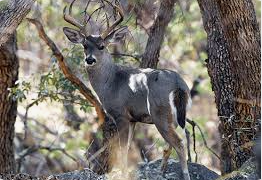Coues Deer
Chances are, if you’ve spent any amount time outside in Arizona you’ve had an encounter
with Coues whitetail deer (Odocoileus virginianus couesi). And if not, we’re going to tell you
about some great places to look for this small, beautiful subspecies of whitetail native to
Arizona and the desert southwest. And who knows…You just might have an
unforgettable deer encounter during your next park visit to a Coues country park!
Physical Characteristics:
The first, most eye-catching
difference between Coues whitetails and their other whitetail cousins is the size. Coues deer
bucks (males) are only about 30 inches tall at the shoulder, and only the biggest bodied
specimens will attain weights of over 100 pounds. As is commonly seen with other types of
deer, Coues deer does (females) are somewhat smaller, and adults average about 65
pounds.
The ears and tails of Coues deer may seem proportionately larger than the whitetails you’re
used to back home. Their large ears are used to help dissipate heat during the hot summer
months. A network of blood vessels in their ears helps cool blood temperature before
returning it to their system. Coues deer also have the familiar flag-like tails
of their whitetail cousins, although larger in comparison to body size. When signaling other
deer of danger, or fleeing the scene, Coues deer tails raise and flare out exposing the large
white underside. White is easy to see in contrast to typical whitetail habitat, and other deer.
The slate gray, or “salt and pepper” coloration of Coues deer differs somewhat from other
whitetail species as well. This helps them blend in with their habitat to aid in the evasion of
their main predators, mountain lions. White or buff colored undersides, white halos around
the eyes and white strips around the muzzles of Coues deer also help park visitors positively
identify them. Of interesting note…Within populations of Coues deer, the top sides of their
tails will vary from reddish, to gray, and even black. This is most likely due to genetics but
nonetheless is fun to see deer with different colored tails within a group.
Body coloration varies throughout the year of individual deer. As the spring days get longer,
Coues deer, like other deer species, shed their winter coat and begin growing a new one. As
the new hair grows, the gray is replaced by a reddish, or sometimes “buckskin” colored fur.
The deer will remain like this throughout the summer until the coat is then replaced once
again by a new winter coat of gray that provides more warmth when temperatures start to
drop.
Viewing
These dainty deer are most active during the
times close to sunrise and sunset, but will often move throughout the day to browse or get a
drink.
full text:https://azstateparks.com/coues-deer


